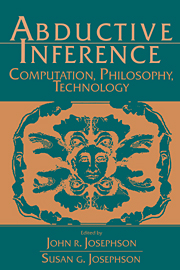Book contents
- Frontmatter
- Contents
- Contributors
- Introduction
- 1 Conceptual analysis of abduction
- 2 Knowledge-based systems and the science of AI
- 3 Two RED systems – abduction machines 1 and 2
- 4 Generalizing the control strategy – machine 3
- 5 More kinds of knowledge: Two diagnostic systems
- 6 Better task analysis, better strategy – machine 4
- 7 The computational complexity of abduction
- 8 Two more diagnostic systems
- 9 Better task definition, better strategy – machine 5
- 10 Perception and language understanding
- Appendix A Truth seekers
- Appendix B Plausibility
- Extended Bibliography
- Acknowledgments
- Index
3 - Two RED systems – abduction machines 1 and 2
Published online by Cambridge University Press: 08 October 2009
- Frontmatter
- Contents
- Contributors
- Introduction
- 1 Conceptual analysis of abduction
- 2 Knowledge-based systems and the science of AI
- 3 Two RED systems – abduction machines 1 and 2
- 4 Generalizing the control strategy – machine 3
- 5 More kinds of knowledge: Two diagnostic systems
- 6 Better task analysis, better strategy – machine 4
- 7 The computational complexity of abduction
- 8 Two more diagnostic systems
- 9 Better task definition, better strategy – machine 5
- 10 Perception and language understanding
- Appendix A Truth seekers
- Appendix B Plausibility
- Extended Bibliography
- Acknowledgments
- Index
Summary
In chapters 1 and 2, we describe abduction, design science, and the generictask approach to building knowledge-based systems. In this chapter we examine the first two of our abductive systems, which we call here RED-1 and RED-2. RED-2 extended RED-1 in several dimensions, the most important being a more sophisticated strategy for assembling composite hypotheses. RED-2 was widely demonstrated and served as a paradigm for our subsequent work on abduction. The RED systems show that abduction can be described precisely enough so that it can be programmed on a digital computer. Moreover, the RED systems do not use methods that are explicitly or recognizably deductive or probabilistic, and thus the RED systems demonstrate evidence-combining inference that apparently goes beyond those classical frameworks.
The red-cell antibody identification task
The RED systems are medical test-interpretation systems that operate in the knowledge domain of hospital blood banks. Our domain experts for these two RED systems were Patricia L. Strohm, MT (ASCP) SBB and John Svirbely, MD. The blood bank is a medical laboratory responsible for providing safe blood and blood products for transfusion. The major activities required are A-B-O and Rh blood typing, red-cell antibody screening, redcell antibody identification, and compatibility testing. The RED systems provide decision support for red-cell antibody identification.
Blood cells have chemical structures on their surfaces called red-cell antigens. When a donor's cells are transfused into a patient, these antigens can be recognized as foreign by the patient's immune system.
- Type
- Chapter
- Information
- Abductive InferenceComputation, Philosophy, Technology, pp. 63 - 93Publisher: Cambridge University PressPrint publication year: 1994



